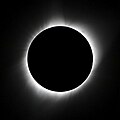| Total eclipse | |
| Gamma | −0.8763 |
|---|---|
| Magnitude | 1.0294 |
| Maximum eclipse | |
| Duration | 149 s (2 min 29 s) |
| Coordinates | 43°12′S89°24′W / 43.2°S 89.4°W |
| Max. width of band | 206 km (128 mi) |
| Times (UTC) | |
| Greatest eclipse | 17:15:23 |
| References | |
| Saros | 127 (61 of 82) |
| Catalog # (SE5000) | 9672 |
A total solar eclipse will occur at the Moon's ascending node of orbit on Thursday, August 3, 2073, [1] with a magnitude of 1.0294. A solar eclipse occurs when the Moon passes between Earth and the Sun, thereby totally or partly obscuring the image of the Sun for a viewer on Earth. A total solar eclipse occurs when the Moon's apparent diameter is larger than the Sun's, blocking all direct sunlight, turning day into darkness. Totality occurs in a narrow path across Earth's surface, with the partial solar eclipse visible over a surrounding region thousands of kilometres wide. Occurring about 3.1 days before perigee (on August 6, 2073, at 18:30 UTC), the Moon's apparent diameter will be larger. [2]
Contents
- Eclipse details
- Eclipse season
- Related eclipses
- Eclipses in 2073
- Metonic
- Tzolkinex
- Half-Saros
- Tritos
- Solar Saros 127
- Inex
- Triad
- Solar eclipses of 2073–2076
- Saros 127
- Metonic series
- Tritos series
- Inex series
- Notes
- References
The path of totality will be visible from parts of southern Chile and Argentina. A partial solar eclipse will also be visible for parts of central and southern South America and the Antarctic Peninsula.






























































































